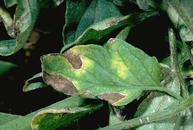
Tomato leaf with powdery mildew (UC Davis – IPM)
Powdery mildew is a common fungal disease that effects many types of plants, and is fairly easy to manage. It causes poor growth and lower yields, but seldom kills the plant. There are many different species of powdery mildew that cause the disease on many different species of plants. See list of species and their hosts below in “Plants Affected”. Unlike many other fungal pathogens, it is able to flourish under warm, dry conditions, when competition (other fungi and bacteria) are not doing well, and doesn’t require wet conditions to germinate.
Physical Description
The white, powdery growth that you see on the leaf surface that starts in small, round spots, and can eventually spread to cover the leaf surface, stem and flower buds. Flower buds will fail to open. The powdery white coating you see is actually thin layers of mycelium that produce spores. The spores make up the bulk of the white stuff you see. The spores can be seen with a microscope or hand lens as chains of clear, white balls.
Species & Taxonomy
- Kingdom:
- Phylum:
- Class:
- Order:
- Family:
- Genus Species: see below, under “Plants Affected”
Lifecycle
The powdery mildew fungi requires living plant tissue on which to grow; as it is a parasitic fungi. Perennial plants allow it to survive through the winter and then infect the annual plants and vegetables. It also survives the winter on weeds. Some species of the fungi produce special spores that remain viable until winter is over. These powdery mildew species are the ones that infect peas, lettuce, parsley, cucumbers, etc. Areas where there is no real frost have an especially hard time with powdery mildew.
A spore of powdery mildew, dispersed by the wind or carried by an insect, lands on a leaf. The spore germinates then grows mycelium. The mycelium of the fungi then grows in a thin layer on the surface of the leaf, shoot, or flower. The mycelium then produces chains spores which are dispersed by wind to new hosts.
All powdery mildew, to different extents, will germinate without water. Free moisture (water droplets, water sprays, rain) actually kills spores and stops mycelial growth. Moderate temperatures (60-80 deg F) and part shade are perfect for an explosion of powdery mildew, since the mycelium and spores are both sensitive to extreme heat and direct sunlight; however, powdery mildew is one of my biggest issues in my garden, which is normally 90 – 110 degrees in the summer (with very low humidity) and full of blazing sunlight.
Plants Affected
- Erysiphe cichoracearum affects composites:
- endive
- lettuce
- parsley
- sunflower
- chrysanthemum
- dahlia
- zinnia
- cucurbits:
- cucumbers
- melons
- squash
- potato
- begonia
- phlox
- Erysiphe cruciferarum affects cole crops:
- broccoli
- brussels sprouts
- cabbage
- cauliflower
- collards
- kale
- kohlrabi
- Erysiphe pisi affects peas
- Leveillula taurica affects:
- artichoke
- eggplant
- pepper
- tomato
- Podosphaera leucotricha affects:
- apple
- quince
- rarely pear
- rarely almond
- Podosphaera oxyacanthae affects leaves and shoots of:
- cherry
- peach
- plum
- Sphaerotheca macularis:
- one strain affects strawberry
- another strain affects raspberry, blackberry and other caneberries
- Sphaerotheca fuliginea affects:
- cucurbits:
- cucumbers
- melons
- squash
- beans
- okra
- black-eyed peas
- cucurbits:
- Sphaerotheca pannosa affects leaves and fruit of:
- apricot
- peach
- plum
- rose
- Uncinula necator affects:
- grapes
- ivy
Plants Unaffected
Geographical Range
Powdery mildew is found everywhere in the United States and Canada.
Signs & Symptoms
Whole Plant
- lackluster growth; powdery film covering stems & leaves
- often look like they’ve been dusted with flour
Leaves
- most easily detected and recognizable symptom: white or light-colored, powdery spots, often covering large areas, on top or on the underside of leaves and/or shoots
- Leaves will eventually turn yellow, die, and fall off
- On tomatoes, eggplants, peppers and artichokes, there is no powdery growth; just irregular yellow patches
- in peppers, the white powdery growth only shows up on the underside of the leaves, then the coating turns brown, and yellow spots appear on the upper side of the leaves…and then the leaves fall off the plant (VGPS)
- on vegetable crops, powdery mildew will first be noticed by yellow spots on top of the leaves, then they will get powdery-looking spots
- leaves are most susceptible 2-3 1/2 weeks of unfolding
Shoots
- light-colored, powdery areas of spore growth
Flowers/Buds
- sometimes the white, powdery spore growth can be seen on flowers
- infected buds are flattened or shriveled
Fruits
- young fruit gets cracked-looking scars in a shattered glass-type of formation (russeting)
- may also show powdery growth
- fruit may ripen slowly or not at all
- powdery mildew seems to suck all of the flavor out of the fruits.
- Especially harmful on grapes and fruit trees.
How to Positively Identify
The white or light-colored, powdery growth on the leaf surface is pretty indicative of powdery mildew. It’s harder to identify on tomatoes, eggplants, peppers, and artichokes, since it just shows as yellow patches. These yellow patches are often confused with other problems, like nutritional deficiencies or other fungal diseases.
Treatment
Prevention & Control
Choosing resistant varieties is the only sure way to avoid powdery mildew, or just not choosing the really susceptible varieties. Although, I don’t think I’ve ever seen a seed catalog describe a cultivar as “exceptionally susceptible to powdery mildew”.
Cultural Controls:
Habitat:
Temperature & Humidity:
- irregular watering and heat leads to more powdery mildew
Mulching & Cultivation Practices:
- don’t plant susceptible crops in shady areas
- provide enough water
- avoid excess fertilizer
- overhead sprinklers, in this case, are desirable. You can also hand-spray frequently to reduce incidences
- watch new growth closely for powdery mildew; pruning off shoots that have it can save you from an epidemic
- keep circulation up by clipping bottom leaves and not planting too densely
- pick off infected leaves
- garden cleanup: the spores can overwinter on plant debris and spread by wind, so remove your plant cuttings and compost (hot composting is good to kill the spores)
Natural Enemies & Biological Controls
- AQ-10: a biofungicide, is a solution of a fungi (Ampelomyces quisqualis) that kills powdery mildew. It is available as a preventive foliar spray, and research shows that it is good for when your disease levels do not exceed 3% on leaves and clusters. This fungi has also shown that it works (in vitro) against some other fungal diseases: Botrytis cinerea, Alternaria solani, Colletotrichum coccodes, and Cladosporium cucumerinum.
- Serenade Garden Disease Control: another biofungicide foliar spray, which uses the bacteria Bacillus subtilis (QST 713, a patented strain) against a broad spectrum of plant diseases. These include scab, powdery mildew, sour rot, downy mildew, and early leaf spot, early blight, late blight, bacterial spot, and walnut blight diseases. It directly attaches and colonizes to fungal pathogens and outcompetes other pathogens. The spray contains bacterial spores of B subtilis and also a protein that the bacteria makes during fermentation. This protein is a natural fungicide that actively assists the bacterium in killing the fungal pathogens. It is approved by NOP and OMRI for use in organic gardening. Spray preventively, before the disease is seen and during, to combat it.
- Actively Aerated Compost Tea:
- full of biological activity, it provides lots of competition for the mildew, potentially also contains bacteria or fungi that kill the powdery mildew fungi
- also fertilizes the plant
- this is best made at home, so it’s fresh
- fungally dominant teas are most effective against powdery mildew
Barriers
Traps
- Trap crops are not a valid method for controlling powdery mildew
Sprays & Dusts
Not in any particular order:
- Water
- Spraying water on your plants should be your first line of defense. If you spray your plants down periodically throughout the week, you can avoid seeing powdery mildew altogether. If you live in a humid area, you may not wish to do this unless you actually have powdery mildew, since it additional free moisture can cause or exacerbate other problems. Water kills the powdery mildew spores and prevents the mycelium from growing.
- Biofungicides
- there are biological controls that are available in a spray-on application. See section above on “Natural Enemies & Biological Controls”.
- Milk
- 1 part milk mixed with 9 parts water slows the spread of powdery mildew
- spray twice per week, but keep refrigerated
- discovered by Wagner Bettiol; he found that this was more effective against powdery mildew than toxic fungicides
- also found to be an effective preventative for tomato mosaic
- Aspirin
- dissolve two uncoated aspirin tablets (325 mg) into 1 quart of water and spray onto infected areas
- Baking Soda and potassium bicarbonate:
- sprays of potassium bicarbonate are supposedly more effective than sodium bicarbonate (baking soda).
- It will also help prevent and reduce other fungal problems.
- Good choice for controlling fungal diseases on cucurbits (squash, cucumber, melons) and tomatoes
- start spraying 2 weeks before you expect symptoms to show up, spraying every 7 days until conditions are not favorable for the powdery mildew; increase frequency if it’s humid
- at home formula:
- 1 teaspoon baking soda (one source recommended 1 tsp, another source recommended 2 tsp; test your plant with the lower concentration first)
- 1 drop liquid soap (another source recommends 2 teaspoons)
- 2 quarts water
- 1 tablespoon of mineral oil (optional; it makes it stick to the leaves and kill some insects)
- spray full-strength via a pump spray bottle or a hudson sprayer
- caution: some foliage can get burned if the concentration of baking soda is too high; just pick off leaves if this happens
- 1% solution works best on grapes & ivy (Uncinula necator)
- Jojoba Oil
- E-RASE is a natural fungicide containing jojoba oil
- toxic to fish
- doesn’t work as well on hairy-leafed plants
- Garlic
- Swedish studies showed 5% solution of garlic extract protected plants from Erysiphe cichoracearum (cucurbits, lettuce, parsley, etc)
- another formula is to mix 1 gallon water with 1.25 cups garlic powder; spray on to plants early in the day
- Soap Sprays
- only soap sprays with sulfur added are effective against powdery mildew; review labels before buying
- Garlic & Diatomaceous Earth Dust
- mix equal parts garlic powder and diatomaceous earth (DE) and use a flour sifter to apply to plants with powdery mildew
- don’t use sifter for cooking after this
- Cinnamon
- combine 1/4 teaspoon ground cinnamon with 1 quart water in a spray bottle; spray both sides of leaves thoroughly
- Neem Oil:
- also known as azadirachtin, however if a product only lists azadirachtin as its active ingredient, then it will not act as a fungicide. Must be the full component of neem oil to work against powdery mildew
- mostly preventive; spray before it shows up, but one study showed that 1% solution controlled 95-100% of the powdery mildew on hydrangeas, phlox, and lilacs when repeated every 7-14 days
- broad spectrum repellant, growth regulator, and insecticide
- also has a bit of a systemic effect
- can harm beneficial insects
- works fastest in hot weather
- Teas
- Comfrey Tea
- Chamomile Tea
- antibacterial & fungicidal
- use as a foliar spray
- also helps prevent damping off
- Chemical Fungicides (sulfur, copper, and other synthetic fungicides) should be your very last ditch effort. The problem with using these is that they kill all fungi indiscriminately. There are many fungi in your soil and on the leaves of your plants that are living symbiotically with your plants. Killing these beneficial fungi that are protecting – and feeding – your plant makes way for a host of other diseases, insects, nematodes and even nutritional problems. Powdery mildew can also become tolerant (resistant) to fungicides, especially systemics.
- Sulfur
- considered to be an organic fungicide
- moderately toxic
- can slightly decreases the pH of your soil – although this can be a bonus, if you live in arid regions
- Sulfur can injure the plant, burning the leaves, if used when it’s over 90 degrees F (although another source stated the threshold as 80 degrees F).
- Sulfur injures some melons no matter what the temperature is.
- Timing of when you spray during the season is important
- doesn’t kill the spores, but it does prevent germination on the plant surface
- Sulfur mixed with lime can kill recently germinated spores
- harms beneficial insects
- Copper
- considered organic
- toxic to humans and animals, very toxic to fish, but it doesn’t harm the beneficial insects
- often combined with sulfate in bordeaux mix, this will inhibit germination and spore production
- Bordeaux Mix:
- combines copper sulfate and hydrated lime
- fungicidal & insecticidal
- click here for more info
Sources:
- Sulfur

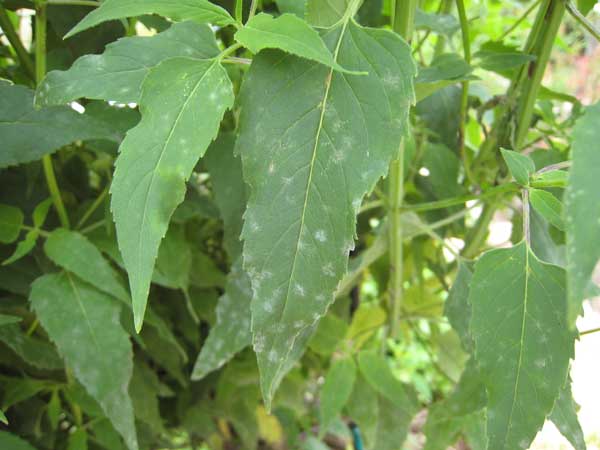
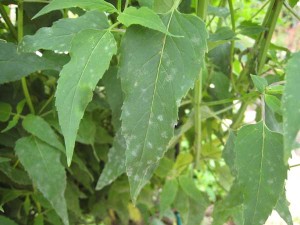

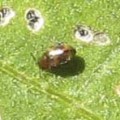
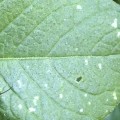
If the powdery mildew is on the plant, can i still eat the fruit or veggie? Is it harmful for humans to ingest or touch or breath in?
Hi Amanda,
I have not noticed any problems with touching it…and in my research, I found nothing referring to it being harmful for humans. Fruits or veggies from plants with powdery mildew are fine to eat. When it is on herbs or greens, you probably can still eat it, but the plant won’t have full production or nutrients, since the leaves are being hijacked.
Hi, I’m trying to find the AQ-10 in the US. I see other articles from 1999 that say it should be available next season. We are well past “next season” and I can’t find it anywhere. Do you know of any place to find it?
Hi there!
I just did a search for Ampelomyces quisqualis (since you weren’t finding AQ-10 for sale) and found a few other potential products that use it…
This EPA fact sheet references Ecogen as the producer of an isolate (M-10) useful for powdery mildew. I’d check them out. here’s that fact sheet: https://www3.epa.gov/pesticides/chem_search/reg_actions/registration/fs_PC-021007_01-Feb-00.pdf
Bio-Dewcon is another product, but it may not be available in the states. Here’s info from the manufacturer: Bio-Dewcon from T Stanes
PowderyCare, also uses Ampelomyces quisqualis, but is from India. Here’s their info sheet: PowderCare from AgriLife
I really hope these have some impact on the powdery mildew! Let us know if you are able to find any of these products.
can I put leaves affected by powdery mildew in my compost bin?
Hi Judi,
Yes, I do put them in my compost piles. The idea behind it is that in a properly managed compost pile, with adequate moisture and air, it will develop a great diversity in microorganisms – some of which will be a consumer of that powdery mildew. Kind of developing your own biocontrol. 🙂
Also, powdery mildew doesn’t do well in moist environments, so it shouldn’t proliferate.